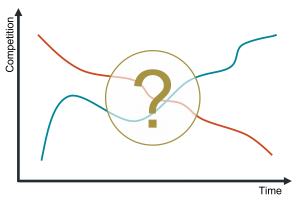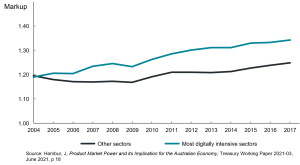Is competition really weakening in Australia?

The Hon Dr Andrew Leigh MP gave an important speech last week in which he concluded that the Australian economy became less competitive from the early 2000s, contributing to declining productivity.
Dr Leigh is right to focus on what we can do to increase productivity and to examine how competition can play a role. However, in our opinion the conclusion that the Australian economy has become less competitive is premature because:
- it is very difficult to measure market power at an economy-wide level; and
- a reduction in competition is just one of the explanations for the observations set out by Dr Leigh.
More research is required on this topic, particularly in careful industry-level analyses that do not suffer from some of the same problems as economy-wide studies.[1]
Very difficult to measure market power at an economy-wide level
Dr Leigh says that a reduction in the job-switching and business start-up rates combined with an increase in mark-ups and the market shares of the largest firms suggest that the Australian economy has become less competitive. However, there are problems with the measurement of the latter two variables.
First, the research referred to by Dr Leigh measures industry concentration by drawing on ANZSIC data at the four-digit level across Australia (eg, 4121 is ‘fresh meat, fish and poultry retailing’ and 4400 is ‘accommodation’). These industries are not the same as markets that are defined to assess the extent of competition because:[2]
- the product dimension of a market may be narrower or wider than the four-digit ANZSIC level – see the figure below;[3] and
- the geographic dimension of a market can sometimes be quite small. For example, the geographic dimension of a retail market may be only one or two suburbs, whereas the ANZSIC data encompasses the whole of Australia.

There is no reason to believe that industry and market concentrations will be correlated. A properly defined product dimension of a market may be more or less concentrated than an industry, and changes in concentration at an Australia-wide level may not affect local levels of concentration. For example, Rossi-Hansberg et al (2018) found that national concentration measures in the United States have been increasing, whilst this is not the case at the local level.[4] This may happen if national firms open new stores in local markets in which they did not previously compete.
Second, the research referred to by Dr Leigh does not measure mark-ups directly, because firm-level marginal costs are generally not available. Instead, mark-ups are estimated by reference to a relationship between:
- the ‘output elasticity’[5] of a firm’s flexible inputs – not observable in the data; and
- the proportion of revenue that it spends on those inputs,[6] on the assumption that firms are setting their mark-ups optimally – these data are observable.
Output elasticity is estimated by:[7]
- assuming a particular ‘production function’, which is an economic tool that relates firm inputs and outputs;
- estimating the parameters of this function, including firm productivity; and
- solving a system of equations to obtain output elasticity estimates.
Implicit in this calculation is a range of assumptions, including the ‘scalar unobservable assumption’ that implies firms with similar levels of productivity will charge similar mark-ups.[8] This assumption fails if firms with the same productivity charge different mark-ups for any reason, which could include, for example, different levels of firm-level demand. If firms with similar productivity in a market do not charge similar mark-ups, the model will produce biased estimates of mark-ups, which in some cases can lead to findings that estimated mark-ups have moved in the opposite direction to reality.[9]
This is consistent with analysis by Triana (2018), who found that market power has either remained flat or declined in the US, when he revises the technique used by De Loecker and Eeckhout (2017) (and by Dr Leigh) – which had found that market power was increasing.[10] Triana also found that earlier research omitted some key costs, such as marketing and management costs, which had led to results that overstate both the level and growth of mark-ups.
Put simply, estimates of mark-ups at an industry or economy level rely on many assumptions and calculations that may not be correct. As far as we are aware, these Australian estimates have not been compared with any firm-level mark-ups from actual, observed data. This would be an important cross-check on the analysis.
Multiple explanations for changes to the variables examined
The economy is a dynamic and complex system made up of a vast number of markets with varying characteristics. There are many possible explanations for changes to the variables described in Dr Leigh’s speech – in our opinion, these observations do not necessarily imply less competition.
First, the job-switching rate may fall if there are fewer firms with higher levels of productivity (and so wages) than others, if people can move around the country more freely without having to switch jobs, or if they can more often find a new job in their current firm.
Second, the business start-up rate may decline if existing businesses are expanding or offering more competitive products and services.
Third, Dr Leigh says that the largest firms have increased their market share. We do not know this is the case for the reasons set out above, but even if it is assumed to be true, they may be expanding because they are offering a better product or price than their rivals, rather than a decrease in competition.
Fourth, mark-ups may increase because competition has reduced, or if:[11]
- changes to technology increases the efficient scale of firms and the proportion of their costs that are fixed;
- changes to the types of products and services being supplied to ones that involve more fixed costs; and
- competition increases so that firms that provide better products (that earn higher margins) and therefore expand more quickly.
There are likely to be other explanations and many of these may act simultaneously. As such, it is difficult to separately identify the effects that are acting without undertaking an analysis at a market level.
Dr Leigh says that mark-ups have increased in the most digitally intensive firms, suggesting that technology and fixed costs are not the only driver of higher mark-ups – see graph below. But another possibility is that all or most of the increase in mark-ups is caused by greater fixed costs and that high-tech industries have invested more in fixed costs than other firms, leading to a greater increase in mark-ups in high-tech industries.

Conclusion
Competition is an important driver of productivity. However, the evidence does not yet support a conclusion that competition has weakened over time in Australia. More research is needed on this topic, particularly in studies that focus on a specific market or industry. For example, a recent study by the Reserve Bank of Australia on the retail sector found evidence that not only has retail competition increased in recent years, mark-ups in that sector had also declined.[12]

[1] This suggestion has been made by others. For example, Berry, S, Gaynor, M and Scott Morton, F, Do Increasing Markups Matter? Lessons from Empirical Industrial Organization, Journal of Economic Perspectives, Volume 33, Number 3, 2019.
[2] This is a well-known problem, and has been described in Berry, S, Gaynor, M and Scott Morton, F, Do Increasing Markups Matter? Lessons from Empirical Industrial Organization, Journal of Economic Perspectives, Volume 33, Number 3, 2019, p 46 and Hambur, J, Product Market Power and its Implication for the Australian Economy, Treasury Working Paper 2021-03, June 2021, p 7.
[3] A supermarket, for example, would be in ANZSIC 4121, in addition to 4122 ‘Fruit and vegetable retailing’ and possibly other categories too. All accommodation is under ANZSIC 4400, but it is likely that some camping groups would not be in the same market as luxury hotels.
[4] Rossi-Hansberg, E, Sarte, P-D and Trachter, N, Diverging trends in national and local concentration, September 2018.
[5] Output elasticity is the change in firm output resulting from a change in the amount of an input. Hambur, J, Product Market Power and its Implication for the Australian Economy, Treasury Working Paper 2021-03, June 2021, p 8; De Loecker, J and Warzynski F, Markups and firm-level export status, American Economic Review, 2012, 102(6), pp 2437-2471.
[6] Hambur, J, Product Market Power and its Implication for the Australian Economy, Treasury Working Paper 2021-03, June 2021, p 29.
[7] Hambur, J, Product Market Power and its Implication for the Australian Economy, Treasury Working Paper 2021-03, June 2021, pp 29-30.
[8] See, for example, Doraszelski, U and Jaumandreu, J, Reexamining the De Loecker & Warzynski (2012) method for estimating markups, CEPR discussion paper no. DP16027, p 3.
[9] Doraszelski, U and Jaumandreu, J, Reexamining the De Loecker & Warzynski (2012) method for estimating markups, CEPR discussion paper no. DP16027, pp 2, 12.
[10] Triana, J, Is aggregate market power increasing? Production trends using financial statements, February 2018, p 16.
[11] This is well-recognised by, for example, Hambur, J, Product Market Power and its Implication for the Australian Economy, Treasury Working Paper 2021-03, June 2021, p 4.
[12] Reserve Bank of Australia, Carter, M, Competition and profit margins in the retail trade sector, June 2019, p 121.